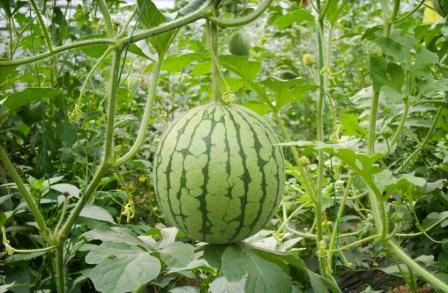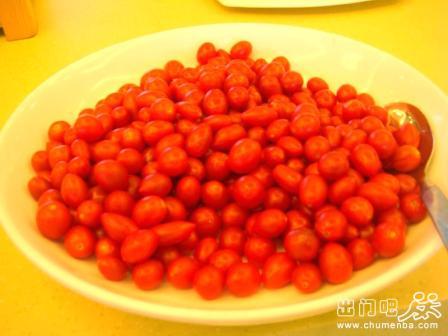Cultivation techniques of watermelon covered with plastic film in open field
First, soil selection, crop rotation
1. Soil selection: choose sandy soil with good courage and large soil porosity, the ground temperature rises rapidly in early spring, which can promote the growth of seedlings, the large temperature difference between day and night is beneficial to the growth and development of plants and the accumulation of sugar in fruits, and clay can be improved. such as more application of organic fertilizer, bacterial residue, grass ash and so on.
2. Crop rotation: continuous cropping of watermelon is the most taboo. Fusarium wilt is easy to occur after continuous cropping. The years of rotation are generally about 7 years. The former crops are mostly wheat, rice, cotton, etc., and the subsequent crops are generally vegetables, such as cabbage, radish, spinach and so on.
3. Intercropping is often intercropped with wheat. Barley, rape. Peanuts can also be interplanted with young orchards and cotton.

Cultivation techniques of watermelon
2. Soil preparation and application of basic fertilizer
First of all, turn the land deeply in the sun, and then apply basic fertilizer, mostly with rotten pig manure or stable manure, the dosage is about 3000kg-4000 kg per mu, and then make 20 kg of formula fertilizer (N:P:K=15:8:27), add a small amount of carbendazim. Insecticides are mixed well and then spread, and finally ridging, ridge spacing 2.5m, ridge height 30cm, each ridge is divided into two rows, making turtle back shape, row spacing 30cm, row height 20cm. Line width 30 cm.
3. Raising seedlings
L, variety selection: select watermelon varieties with middle and late maturity, disease resistance, high quality and high yield, such as disease-resistant Qiluwang, Dongbeilong, Xinong 8 and so on.
2. Preparation of nutritious soil: according to the calculation of 12 square meters of seedbed per mu, 1000 nutrition bowls are needed. Use farm manure (mix well with a small amount of plant ash) about 150kg, add clean pastoral soil about 350kg (proportion is 3:7, total nutritious soil 500kg), add formula can be about 5kg, disinfect with 65% mancozeb powder (about 20kg), mix well, cover with plastic film for 2rel for 3 days, remove and use after the smell of the medicine has dissipated.
3. Set up a sunny bed for raising seedlings, plus a small arch shed. The width of the border is 1.2 meters, and the length is calculated according to 10 meters per mu. An electric hot line can be laid at the bottom of the border, and then the nutrient soil can be loaded into the nutrient body and arranged neatly and tightly in the seedbed.
4. Sowing: A. sowing time: the seedling age of watermelon is about 30 days, and the sowing time is determined by the planting time. The planting time in Xi'an is generally in the middle of April, so the sowing time should be about March 10. B, sowing rate: about 200 grams per mu. C, seed treatment: select seeds, expose them in the sun for 2 days, stir the seeds in 55 ℃ of warm water for 5 minutes, soak the seeds for 6 hours after cooling, wrap them in a container with a sterilized wet cloth, accelerate germination under 25 ℃ (or with the force and method of body temperature), rinse the seeds once the next day, sprout after 3 days, and sow 70% of the seeds after exposure. D, sowing method: one day before sowing, the seedbed should be watered once (be careful not to wash away the nutritious soil), and the soil temperature should reach 28 ℃. Then the radicle of the seed should be lowered into the nutrition bowl, 1 grain per bowl (2 seeds for unbudded sowing), covered with 1 cm of nutritive soil, covered with plastic film and fastened with a small arch shed.
5. Seedling stage management
A. adopt high temperature to raise seedlings, that is, the soil temperature should be controlled at 28 ℃ before emergence, and the soil temperature should be reduced in time after emergence (about 70%). It should be controlled at 22 ℃ 25 ℃ during the day and 20 ℃ at night, and then gradually cool down and refine the seedlings 10 days before transplanting, so that the soil temperature of the seedling bowl is close to that of the planting soil (about 15 ℃).
B. Water and fertilizer management of seedling bed: in addition to temperature, the focus of seedling bed management is temperature control, that is, to reduce the humidity of seedling bed and watering times as much as possible. in principle, water is watered after drying and whitening on the surface of nutrition bowl soil, and at the same time pay attention to ventilation and ventilation and spray once after seedling emergence, so as to prevent and control blight and sudden collapse.
IV. Live broadcast in the open air
1. Sowing method: using the method of accelerating germination and direct seeding, first dig the sowing hole according to the plant spacing in the melon row, and then water it in the hole, pouring at least one large bowl in each hole, and shovel a sowing ditch with melon after the water seeps, with a depth of about 1.5ml 2cm. When sowing, stick the tip of the seed bud down on the furrow of the sowing ditch, sow 3 seeds per hole, cover about 1.5 cm with fine soil, and cover with plastic film.
2. Release seedlings: cut a hole in the plastic film at the place of emergence, so that the seedlings are exposed outside the film, and seal the break of the plastic film with soil after releasing the seedlings.
5. Colonization:
1. Planting density: 2 rows per ridge, the spacing between rows is 30 cm, the distance between plants is 60 mi 65 cm, and about 700 plants are planted per mu.
2. Planting method: the two rows are staggered by triangular planting method, and the caves are made according to the distance of 60cm between plants. Each hole is poured with enough fixed planting water, and then the seedlings are put in, paying attention to keeping the nutritious soil intact. Cover the plastic film after transplanting, pay attention to expose the seedlings when covering the plastic film, and compact the seedlings with fine soil around the seedlings.
6. Pruning, pressing vines and selecting young melons:
1. Three-vine pruning: except for the main vine outside, there is one side vine on each side near the 8 nodes of the main vine, with a total of three vines. The excess side branches should be erased in time before setting fruit. Except for seedling protection and fruit setting, the lateral buds of other side branches should be wiped out completely, and the times of erasing should be reduced or not erased after fruit setting.
2. Pressing vine: when the melon vine is elongated, take the soil between the rows and flatten one side on the internodes of the stem vine, usually every 3 meters and 4 knots. Note that the two lines on each ridge should be pressed to both sides separately, and the middle line should be set aside for operation.
3. Select and retain young melons: the young melons with the second or third female flowers before and after the fifth node of the main vine are more suitable, leaving one melon per plant first, and only the second stubble melon is selected when the first stubble melon is close to maturity. Leave the melon after leaving the melon combined with artificial pollination, do not pinch the head before sitting down, pay attention to pruning and forking, and erase the lateral buds. Pinch the head when the melon sits down to the size of an egg and control its growth. In the crazy growth can not sit melon, often the stem vine kneading in order to control overgrowth.
Topdressing and watering
1. Topdressing: control the use of nitrogen fertilizer and limit the use of chlorine-containing fertilizer and its compound fertilizer. In the fruit setting stage and fruit expansion period, topdressing with water is applied twice, about 10 kg of formula fertilizer is used each time, and foliar fertilizer can be added in the early stage. Topdressing combined with watering, topdressing between the two rows on the ridge every time, is conducive to full absorption.
2. Watering: generally, there is no watering in front of the melon, especially drought or a little water when needed. After setting melons, water the young fruit and eggs for the first time, mostly irrigate the fields in the melon border and try to water evenly, usually once a week, so stop watering 3 times when the water is almost ripe.
Related
- A course of planting techniques and methods on how to grow carrots
- How to plant the latest tulips?
- Is it better to pick tea in the morning or in the afternoon? When is the best time for tea to be picked? what is the third or fifth tea?
- Launch Yuanxiao Happy combination Haocha + Tea Yuan healthy Taste
- Penghu Tourism "Fireworks 20 Parade with You"
- 2022 West Lake Happiness holds "Digital Revitalization Voucher" and draws iphone13 and laptop.
- Banqiao Fuzhou social houses are designed to change start-up combined with police elimination to create a safe and livable environment
- The convenient measure of "mechanical weeding" in Xinbei has been abused and the Agriculture Bureau has imposed heavy penalties on the illegal land consolidation.
- Changgeng University Joins Hands with Four Memory Factories to Rescue Memory Talent Shortage
- The list of Taiwan's top 100 MVP managers is listed by the Director-General of the Farmers' Association of Sanxia District.



